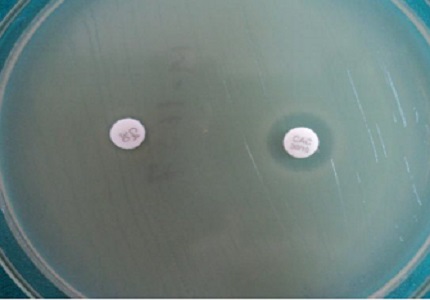Incidence of infections with extended spectrum beta Lactamase (ESBL)-producing gram-negative bacteria among patients admitted in medical intensive care unit of tertiary care hospital
Abstract
Introduction: Extended spectrum beta-lactamases (ESBLs) are beta-lactamases capable of conferring bacterial resistance to the Penicillins, first, second and third generation cephalosporins, and Aztreonam (but not the Cephamycins or Carbapenems). Clinicians, Microbiologists and hospital epidemiologists are concerned about ESBL-producing Gram negative bacteria because of increased incidence of such infections, limitations of effective antimicrobial therapy and adverse patient outcomes.
Aims and Objectives: To find the incidence of infections caused by ESBL producing Gram negative bacteria among patients admitted in Medical ICU of tertiary care hospital. To compare the antimicrobial susceptibility patterns of the ESBL producing Gram negative isolates with ESBL non-producing isolates.
Materials and Methods: Clinical samples were collected from patients admitted in Medical ICU & processed as per standard protocol. Antibiotic susceptibility was performed by Kirby-Bauer disc diffusion method. Screening for ESBL production was done as per CLSI guidelines. Presence of ESBL was detected by Phenotypic confirmatory disc diffusion method using discs containing 30µg of Ceftazidime with and without 10µg of Clavulanic acid on Mueller-Hinton Agar.
Results: A total of 50 samples were collected. Of these, majority (38%) of samples were urine followed by sputum (36%). Of the 50 samples, majority of the isolates were Klebsiella spp and E.coli, 14(28%) each. Among 50 samples, 42(84%) isolates were ESBL producers. Of the 42 ESBL producing organisms, majority(13(30.9%)) of them were Klebsiella spp.
Conclusion: In the present study, we found an alarming number(84%) of ESBL producing Gram negative isolates in Medical ICU patients. Strict antibiotic policies and measures to limit indiscriminate use of Cephalosporins should be undertaken to minimize the emergence of such resistance.
Downloads
References
2. Paterson DL, Bonomo RA. Extended-spectrum beta-lactamases: a clinical update. Clin Microbiol Rev. 2005 Oct;18(4):657-86.
3. Grover CN, Sahni AK, Bhattacharya CS. Therapeutic challenges of ESBL and AmpC beta-lactamase producers in a tertiary care center. Indian medical journal of armed forces 2013;69(1):4-10.
4. Paterson DL, Bonomo RA. Extended-spectrum beta-lactamases: a clinical update. Clin Microbiol Rev. 2005 Oct;18(4):657-86. [PubMed]
5. Nathisuwan S, Burgess DS, Lewis JS 2nd. Extended-spectrum beta-lactamases: epidemiology, detection, and treatment. Pharmacotherapy. 2001 Aug;21(8):920-8.
6. Tsering DC, Das S, Adhiakari L, Pal R, Singh TS. Extended Spectrum Beta-lactamase Detection in Gram-negative Bacilli of Nosocomial Origin. J Glob Infect Dis. 2009 Jul;1(2):87-92. doi: 10.4103/0974-777X.56247.
7. Rupp ME, Fey PD. Extended spectrum beta-lactamase (ESBL)-producing Enterobacteriaceae: considerations for diagnosis, prevention and drug treatment. Drugs. 2003;63(4):353-65.
8. Babini GS, Livermore DM. Antimicrobial resistance amongst Klebsiella spp. collected from intensive care units in Southern and Western Europe in 1997-1998. J Antimicrob Chemother 2000; 45:183-9.
9. Clinical and Laboratory Standards Institute. Performance standards for antimicrobial susceptibility testing; 18th informational supplement 2012.
10. Das A, Ray P, Garg R, Kaur B. Extended spectrum beta-lactamase production in Gram negative bacterial isolates from cases of septicemia. Proceedings of the Silver Jubilee Conference of IAMM. New Delhi: All India institute Of medical Sciences; 2001.
11. Babypadmini S, Appalaraju B. Extended spectrum -lactamases in urinary isolates of Escherichia coli and Klebsiella pneumoniae - prevalence and susceptibility pattern in a tertiary care hospital. Indian J Med Microbiol. 2004 Jul-Sep;22(3):172-4.
12. Tankhiwale SS, Jalgaonkar SV, Ahamad S, Hassani U. Evaluation of extended spectrum beta lactamase in urinary isolates. Indian J Med Res. 2004 Dec;120(6):553-6. [PubMed]
13. Mohanty S, Singhal R, Sood S, Dhawan B, Das BK, Kapil A. Comparative in vitro activity of beta-lactam/beta-lactamase inhibitor combinations against gram negative bacteria. Indian J Med Res. 2005 Nov;122(5):425-8.
14. Taneja N, Rao P, Arora J, Dogra A. Occurrence of ESBL & Amp-C beta-lactamases & susceptibility to newer antimicrobial agents in complicated UTI. Indian J Med Res. 2008 Jan;127(1):85-8.
15. Shashwati N, Kiran T, Dhanvijay AG. Study of Extended spectrum β- lactamase producing Enterobacteriaceae and antibiotic co-resistance in a tertiary care teaching hospital. J Nat Sci Biol Med. 2014; 5(1): 30-5.
16. Bajpai T, Pandey M, Varma M, Bhatambare GS. Prevalence of extended spectrum beta-lactamase producing uropathogens and their antibiotic resistance profile in patients visiting a tertiary care hospital in central India: Implications on empiric therapy. Indian J Pathol Microbiol. 2014 Jul-Sep;57(3):407-12. doi: 10.4103/0377-4929.138733.
17. Itokazu GS, Quinn JP, Bell-Dixon C, Kahan FM, Weinstein RA. Antimicrobial resistance rates among aerobic gram-negative bacilli recovered from patients in intensive care units: evaluation of a national postmarketing surveillance program. Clin Infect Dis. 1996 Oct;23(4):779-84.
18. Kaul S, Brahmadathan KN, Jagannati M. one year trends in the Gram negative bacterial antibiotic susceptibility patterns in a Medical ICU in South India. 2007; 25(3): 230-235.



 OAI - Open Archives Initiative
OAI - Open Archives Initiative


